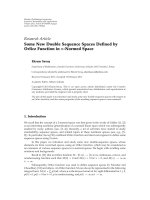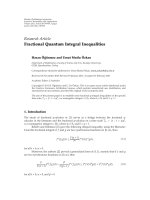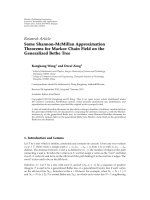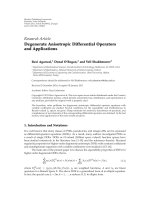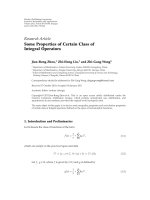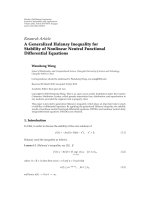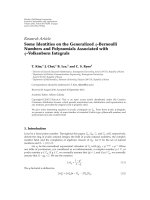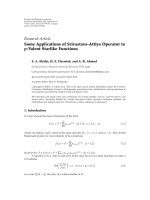Báo cáo hóa học: "Research Article Some Generalized Error Inequalities and Applications" pot
Bạn đang xem bản rút gọn của tài liệu. Xem và tải ngay bản đầy đủ của tài liệu tại đây (509.08 KB, 15 trang )
Hindawi Publishing Corporation
Journal of Inequalities and Applications
Volume 2008, Article ID 845934, 15 pages
doi:10.1155/2008/845934
Research Article
Some Generalized Error Inequalities
and Applications
Fiza Zafar
1
and Nazir Ahmad Mir
2
1
Centre for Advanced Studies in Pure and Applied Mathematics, Bahauddin Zakariya University,
Multan 60800, Pakistan
2
Department of Mathematics, COMSATS Institute of Information Technology, Plot no. 30,
Sector H-8/1, Islamabad 44000, Pakistan
Correspondence should be addressed t o Fiza Zafar, fi
Received 4 February 2008; Revised 30 May 2008; Accepted 29 July 2008
Recommended by Sever Dragomir
We present a family of four-point quadrature rule, a generalization of Gauss-two point, Simpson’s
3/8, and Lobatto four-point quadrature rule for twice-differentiable mapping. Moreover, it is
shown that the corresponding optimal quadrature formula presents better estimate in the context
of four-point quadrature formulae of closed type. A unified treatment of error inequalities for
different classes of function is also given.
Copyright q 2008 F. Zafar and N. A. Mir. This is an open access article distributed under the
Creative Commons Attribution License, which permits unrestricted use, distribution, and
reproduction in any medium, provided the original work is properly cited.
1. Introduction
We define
If
b
a
fxdx. 1.1
The problem of approximating I f is usually referred to as numerical integration or
quadrature 1. Most numerical integration formulae are based on defining the approxi-
mation by using polynomial or piecewise polynomial interpolation. Formulae using such
interpolation with evenly spaced nodes are referred to as Newton-Cotes formulae. The
Gaussian quadrature formulae, which are optimal and converge rapidly by selecting the node
points carefully that need not be equally spaced, are investigated in 2.
In 3–5, the quadrature problem, in particular, the investigation of error bounds of
Newton-Cotes formulae, namely, the mid-point, trapezoid, and Simpson’s rule have been
carried out by the use of Peano kernel approach in terms of variety of norms, from an
inequality point of view.
2 Journal of Inequalities and Applications
The deduction of the optimal quadrature formulae in the sense of minimal error
bounds has not received the right attention as long as the work by Ujevi
´
c see 6–8 and 9,
pages 153–166, who used a new approach for obtaining optimal two-point and three-point
quadrature formulae of open as well as closed type, has not appeared. Further, some error
inequalities have also been presented by Ujevi
´
c to ensure the applications of these optimal
quadrature formulae for different classes of functions.
In this paper, we present an approach similar to that of Ujevi
´
c’s 6 to present some
improvements and generalizations in this context.
Let us first formulate the main problem.
Consider
Kx, y, t
⎧
⎪
⎪
⎪
⎪
⎪
⎪
⎪
⎨
⎪
⎪
⎪
⎪
⎪
⎪
⎪
⎩
1
2
t − α
2
α
1
,t∈ a, x,
1
2
t − β
2
β
1
,t∈ x, y,
1
2
t − γ
2
γ
1
,t∈ y,b,
1.2
as defined in 6, where x, y ∈ a hb − a,b − hb − a, h ∈ 0, 1/2, x<y,and
α, α
1
,β,β
1
,γ,γ
1
∈ R are parameters which are required to be determined.
We know that the exact value of the remainder term of the integral
b
a
Kx, y, tf
tdt
may not be found, thus, we may proceed as
b
a
Kx, y, tf
tdt
≤ max
t∈a,b
|f
t|
b
a
|Kx, y, t|dt. 1.3
The main aim of this paper is to present a minimal estimation of the error bound 1.3
by appropriately choosing the variables and parameters involved. Moreover, it is worth
mentioning that the family of quadrature formulae thus obtained hereafter is a generalization
of that presented in 6.
2. A generalized optimal quadrature formula
Consider the above stated error inequality problem for a −1, b 1, so that x, y ∈ −1
2h, 1 − 2h. We will try to find out an optimal quadrature formula of the form
1
−1
ftdt − hf−11 − hfx1 − hfyhf1
1
−1
Kx, y, tf
tdt, 2.1
where Kx, y, t is defined by 1.2 with a −1, b 1, and x, y ∈ −1 2h, 1 − 2h with x<y,
h ∈ 0, 1/2.
The parameters α, a
1
,β,β
1
,γ,γ
1
∈ R involved in Kx, y, t are required to be deter-
mined in a way such that the representation 2.1 is obtained.
F. Zafar and N. A. Mir 3
Integrating by parts right-hand side of 2.1, we have
1
−1
Kx, y, tf
tdt −
1
2
1 α
2
α
1
f
−1
1
2
1 − γ
2
γ
1
f
1
1
2
{x − α
2
− x − β
2
} α
1
− β
1
f
x
1
2
{y − β
2
− y − γ
2
} β
1
− γ
1
f
y − 1 αf−1
− 1 − γf1α − βfxβ − γfy
1
−1
ftdt.
2.2
For the representation 2.1, we require from 2.2
1
2
x − α
2
α
1
−
1
2
x − β
2
− β
1
0,
1
2
y − β
2
β
1
−
1
2
y − γ
2
− γ
1
0,
1
2
1 α
2
α
1
0,
1
2
1 − γ
2
γ
1
0,
β − γ −1 − h,
α − β −1 − h,
1 α h,
1 − γ h.
2.3
This gives through simple calculations:
α −1 −h,γ1 − h,β 0,
γ
1
−
1
2
h
2
,
α
1
−
1
2
h
2
,
β
1
1
2
− h 1 − hx
1
2
− h − 1 − hy.
2.4
4 Journal of Inequalities and Applications
Henceforth,
y −x. 2.5
So, we have
Kx, t
⎧
⎪
⎪
⎪
⎪
⎪
⎪
⎪
⎪
⎨
⎪
⎪
⎪
⎪
⎪
⎪
⎪
⎪
⎩
1
2
t 1 − h
2
−
1
2
h
2
,t∈ −1,x,
1
2
t
2
1 − hx − h
1
2
,t∈ x, y,
1
2
t − 1 − h
2
−
1
2
h
2
,t∈ y,1.
2.6
We further see that
1
−1
Kx, tf
tdt
≤f
∞
1
−1
|Kx, t|dt. 2.7
We are now required to find an x that minimizes
1
−1
|Kx, t|dt.
We next define
Gx
1
−1
|Kx, t|dt
1
2
x
−1
|t 1 − h
2
− h
2
|dt
y
x
1
2
t
2
1 − hx − h
1
2
dt
1
2
1
y
|t − 1 − h
2
− h
2
|dt,
2.8
and consider the problem
minimize Gx,x∈ −1 2h, 1 − 2h,h∈
0,
1
2
. 2.9
Hence, we would like to find a global minimizer of G. Recall that a global minimizer is a point
x
∗
that satisfies
Gx
∗
≤ Gx ∀x ∈ −1 2h, 1 − 2h,h∈
0,
1
2
. 2.10
F. Zafar and N. A. Mir 5
We now consider the following cases.
i Let x ∈ −1 − 2h, h − 1/2/1 − h. Then by symmetry, we may consider
G
1
x−
1
2
−12h
−1
t 1 − h
2
− h
2
dt
1
2
x
−12h
t 1 − h
2
− h
2
dt
1
2
−
√
2h−1−21−hx
x
t
2
21 − hx − 2h 1dt
−
1
2
0
−
√
2h−1−21−hx
t
2
21 − hx − 2h 1dt
1
6
−
1
2
1 − hx
2
−
4
3
1 − h
2h − 1 − 21 − hxx
4
3
h −
1
2
2h − 1 − 21 − hx
4
3
h
3
−
h
2
.
2.11
We may note that
Gx2G
1
x. 2.12
Combining 2.11 and 2.12 with 2.1 and 2.7,weget
1
−1
ftdt − hf−11 − hfx1 − hf−xhf1
≤
1
3
− 1 − hx
2
−
8
3
1 − h
2h − 1 − 21 − hxx
8
3
h −
1
2
2h − 1 − 21 − hx
8
3
h
3
− h
f
∞
.
2.13
Moreover, simple calculations show that G
1
x0for
x
1,2
−4 4h ± 2
3 − 6h 4h
2
. 2.14
It is not difficult to find that
G
1
x
1
> 0,G
1
x
2
< 0. 2.15
6 Journal of Inequalities and Applications
Thus, x
1
is the local minimizer of Gx for x ∈ −1 − 2h, h − 1/2/1 − h. We have
G
1
x
1
52
3
h
3
− 44h
2
83
2
h −
83
6
81 − h
2
4h
2
− 6h 3
2
3
8h
2
− 14h 7
8h
2
− 14h 7 − 41 − h
4h
2
− 6h 3
−
8
3
1 − h
8h
2
− 14h 7 − 41 − h
4h
2
− 6h 3
4h
2
− 6h 3,
2.16
such that
Gx
1
2G
1
x
1
. 2.17
ii Next, we check the point x
3
h − 1/2/1 − h. We find that min
h∈0,1/2
G
1
x
1
<
min
h∈0,1/2
G
1
x
3
.
Thus, from the above considerations, we find that x
∗
−4 4h 2
3 − 6h 4h
2
is the
global minima of G. Therefore, we get the following conclusion.
Theorem 2.1. Let I ⊂ R be an open interval such that −1, 1 ⊂ I and let f : I →R be a twice
differentiable function such that f
is bounded and integrable. Then,
1
−1
ftdt
hf−11−hf−4 4h2
3−6h 4h
2
1−hf4 − 4h−2
3−6h4h
2
hf1Rf,
2.18
where
|Rf|≤2Δhf
∞
, 2.19
h ∈ 0, 1/2, and Δh is defined as
Δh
52
3
h
3
− 44h
2
83
2
h −
83
6
81 − h
2
4h
2
− 6h 3
2
3
8h
2
− 14h 7
8h
2
− 14h 7 − 41 − h
4h
2
− 6h 3
−
8
3
1 − h
8h
2
− 14h 7 − 41 − h
4h
2
− 6h 3
4h
2
− 6h 3.
2.20
Proof. From the above discussion, we find that 2.18 holds with
Rf
1
−1
K−4 4h 2
3 − 6h 4h
2
,tf
tdt, 2.21
F. Zafar and N. A. Mir 7
and Kx, t is given by 2.6 with y −x. We further have
|Rf|≤f
∞
1
−1
|K−4 4h 2
3 − 6h 4h
2
,t|dt
G−4 4h 2
3 − 6h 4h
2
f
∞
.
2.22
Since G−4 4h 2
3 − 6h 4h
2
2G
1
−4 4h 2
3 − 6h 4h
2
,thus2.19 holds.
We would like now to mention here some special cases of 2.13.
Remark 2.2. As it has been mentioned in 6, we recapture the Gauss two-point quadrature
formula for h 0andx −
√
3/3.
Remark 2.3. It may be noted that for h 1/6andx −
√
5/5, we get Lobbato four-point
quadrature rule as follows:
1
−1
ftdt
1
6
f−15f
−
√
5
5
5f
√
5
5
f1
R
1
f, 2.23
where
|R
1
f|≤C
1
f
∞
, 2.24
and C
1
1/81 4/27
−6 3
√
5
√
5 − 2 ≈ 0.0418.
Remark 2.4. For h 1/4andx −1/3, we get 3/8 Simpson’s rule as follows:
1
−1
ftdt
1
4
f−13f
−
1
3
3f
1
3
f1
R
2
f, 2.25
where
|R
2
f|≤C
2
f
∞
, 2.26
and C
2
1/24 ≈ 0.0417.
Remark 2.5. Keeping in view the above special cases, 2.13 may be considered as a
generalization of Gauss two-point, Simpson’s 3/8 and Lobatto four-point quadrature rule
for twice differentiable mappings.
Remark 2.6. For h 1/5, Δh attains its minimum value.
8 Journal of Inequalities and Applications
Corollary 2.7. Let t he assumptions of Theorem 2.1 hold. Then, one has the following optimal quadra-
ture rule:
1
−1
ftdt
1
5
f−14f
−
2
5
4f
2
5
f1
R
3
f, 2.27
|R
3
f|≤C
3
f
∞
, 2.28
where C
3
14/375 ≈ 0.0373.
Remark 2.8. The comparison of 2.23, 2.25,and2.27 shows that the latter presents a much
better estimate in the context of four-point quadrature rules of closed type.
By considering the problem on the interval a, b, the following theorem is obvious.
Theorem 2.9. Let I ⊂ R be an open interval such that a, b ⊂ I and let f : I →R be a twice-
differentiable function such that f
is bounded and integrable. Then,
b
a
ftdt
1
2
b − ahfa1 − hfx
1
1 − hfx
2
hfb Rf,
2.29
where
x
1
b − a
2
x
∗
a b
2
,x
2
−
b − a
2
x
∗
a b
2
, 2.30
with
x
∗
−4 4h 2
3 − 6h 4h
2
,
|Rf|≤
1
4
Δhb − a
3
f
∞
,
2.31
h ∈ 0, 1/2, and Δh is as defined above.
3. Generalized error inequalities
From the basic properties of the L
p
a, b spaces for p 1, 2, ∞, we know that L
2
a, b is a
Hilbert space with the inner product defined as
f, g
2
b
a
ftgtdt. 3.1
We now define X L
2
a, b, ·, ·
2
. In the space X, the norm ·
2
is defined in the usual
manner as
f
2
b
a
f
2
tdt
1/2
. 3.2
F. Zafar and N. A. Mir 9
Let us also consider Y L
2
a, b, ·, ·, where the inner product ·, · is defined by
f, g
1
b − a
b
a
ftgtdt 3.3
with the corresponding norm ·defined by
f
f, f. 3.4
We know that the Chebyshev functional is defined as
Tf, gf, g−f, eg,e, 3.5
where f, g ∈ L
2
a, b and e 1 which satisfies the pre-Gr
¨
uss inequality 4, page 296 or 5,
page 209:
T
2
f, g ≤ Tf, fTg,g. 3.6
Let us denote
σfσf; a, b
b − aTf, f3.7
as defined in 6. Moreover, the space L
1
a, b is a Banach space with the norm
f
1
b
a
|ft|dt, 3.8
and the space L
∞
a, b is also a Banach space with the norm
f
∞
ess sup
t∈a,b
|ft|. 3.9
So, if f ∈ L
1
a, b and g ∈ L
∞
a, b, then we have
|f, g
2
|≤f
1
g
∞
. 3.10
Finally, we define
JfJf; a, b; h
b
a
ftdt −
1
2
b − ahfa1 − hfx
1
1 − hfx
2
hfb,
3.11
where x
1
and x
2
are given by 2.30.
10 Journal of Inequalities and Applications
We would also like to mention the following lemma 10.
Lemma 3.1. Let
ft
⎧
⎪
⎪
⎪
⎨
⎪
⎪
⎪
⎩
f
1
t,t∈ a, x
1
,
f
2
t,t∈ x
1
,x
2
,
f
3
t,t∈ x
2
,b,
3.12
where a<x
1
<x
2
<b,f
1
∈ C
1
a, x
1
,f
2
∈ C
1
x
1
,x
2
,f
3
∈ C
1
x
2
,bf
1
x
1
f
2
x
1
, and
f
2
x
2
f
3
x
2
.If
sup
t∈a,x
1
|f
1
t| < ∞, sup
t∈x
1
,x
2
|f
2
t| < ∞, sup
t∈x
2
,b
|f
3
t| < ∞, 3.13
then the function f is an absolutely continuous function.
Theorem 3.2. Let f : −1, 1 →R be a function such that f
∈ L
1
−1, 1. If there exists a real number
γ
1
, such that γ
1
≤ f
t,t∈ −1, 1, then
|Jf; −1, 1; h|≤2Δ
0
hS − γ
1
, 3.14
and if there exists a real number Γ
1
, such that f
t ≤ Γ
1
, t ∈ −1, 1, then
|Jf; −1, 1; h|≤2Δ
0
hΓ
1
− S, 3.15
where Jf; −1, 1; h is defined by 3.11, S f1 − f−1/2, and h ∈ 0, 1/2. If there exist real
numbers γ
1
, Γ
1
, such that γ
1
≤ f
t ≤ Γ
1
, t ∈ −1, 1, then
|Jf; −1, 1; h|≤
1
2
Δ
1
hΓ
1
− γ
1
, 3.16
Δ
0
h and Δ
1
h are defined as
Δ
0
h2
4h
2
− 6h 3 − 31 − h,
Δ
1
h58h
2
− 98h 49 − 281 − h
4h
2
− 6h 3.
3.17
Proof. In order to prove 3.16,letusdefine
p
1
t
⎧
⎪
⎪
⎨
⎪
⎪
⎩
t 1 − h, t ∈ −1,x,
t, t ∈ x, y,
t − 1 − h,t∈ y,1,
3.18
F. Zafar and N. A. Mir 11
where x −4 4h 2
3 − 6h 4h
2
and y −x. Note that since p
1
,e
2
0, thus
p
1
,f
2
−Jf; −1, 1; h,
f
−
Γ
1
γ
1
2
,p
1
2
f
,p
1
2
.
3.19
From 3.10,
f
−
Γ
1
γ
1
2
,p
1
2
≤
f
−
Γ
1
γ
1
2
∞
p
1
1
≤
1
2
Δ
1
hΓ
1
− γ
1
,
3.20
as
f
−
Γ
1
γ
1
2
∞
≤
Γ
1
− γ
1
2
,
p
1
1
58h
2
− 98h 49 − 281 − h
√
4h
2
− 6h 3.
3.21
From 3.19 and 3.20, it may be observed that 3.16 holds. Further, it can be seen that
|f
− γ
1
,p
1
2
|≤p
1
∞
f
− γ
1
1
2Δ
0
hS − γ
1
,
3.22
since
p
1
∞
2
4h
2
− 6h 3 − 31 − h,
f
− γ
1
1
1
−1
f
t − γ
1
dt
f1 −f−1 − 2γ
1
2S − γ
1
.
3.23
Hence, 3.14 holds. In the similar manner, we can prove 3.15.
Remark 3.3. It may be noted that Δ
0
h has its minimum value 0.396 at h 0.259. In a similar
way, it may be observed that 1/2Δ
1
h attains its minimum value 0.1698 at h 0.296.
Theorem 3.4. Let f : a, b →R be a function, such that f
∈ L
1
a, b. If there exists a real number
γ
1
, such that γ
1
≤ f
t, t ∈ a, b, then
|Jf; a, b; h|≤
1
2
Δ
0
hS − γ
1
b − a
2
, 3.24
12 Journal of Inequalities and Applications
and if there exists a real number Γ
1
, such that f
t ≤ Γ
1
,t∈ a, b, then
|Jf; a, b; h|≤
1
2
Δ
0
hΓ
1
− Sb − a
2
, 3.25
where Jf; a, b; h is defined by 3.11 and S fa −fb/b −a and h ∈ 0, 1/2. If there exist
real numbers γ
1
, Γ
1
, such that γ
1
≤ f
t ≤ Γ
1
, t ∈ a, b, then
|Jf; a, b; h|≤
1
8
Δ
1
hΓ
1
− γ
1
b − a
2
, 3.26
Δ
0
h and Δ
1
h are as defined in 3.17.
Theorem 3.5. Let f : −1, 1 →R be an absolutely continuous function, such that f
∈ L
2
−1, 1.
Then,
|Jf; −1, 1; h|≤
Δ
2
hσf
; −1, 1, 3.27
where σf
; −1, 1 is defined by 3.7 and
Δ
2
h−56h
3
154h
2
− 146h
146
3
− 281 − h
2
4h
2
− 6h 3 3.28
for h ∈ 0, 1/2.
Proof. Let p
1
be the same as defined above. We have
p
1
,f
2
−Jf; −1, 1; h, 3.29
since p
1
,e
2
0, if a, b−1, 1. Moreover, f, g 1/2f, g
2
and
p
1
,f
Tf
,p
1
. 3.30
From 3.6, it follows that
Tf
,p
1
≤
Tp
1
,p
1
Tf
,f
1
2
p
1
2
σf
; −1, 1
1
2
Δ
2
hσf
; −1, 1,
3.31
as
p
1
2
2
−56h
3
154h
2
− 146h
146
3
− 281 − h
2
4h
2
− 6h 3. 3.32
Using 3.29, 3.30, 3.31,and3.32, inequality 3.27 is proved.
F. Zafar and N. A. Mir 13
Remark 3.6.
Δ
2
h attains its minimum value 0.2799 at h 0.2957.
Theorem 3.7. Let f : a, b →R be an absolutely continuous function, such that f
∈ L
2
a, b. Then,
|Jf; a, b; h|≤
1
2
√
2
Δ
2
hσf
; a, bb − a
3/2
, 3.33
where σf
; a, b is defined by 3.7 and Δ
2
h is as defined above.
4. Applications in numerical integration
Let π {x
0
a<x
1
< ··· <x
n
b} be a subdivision of the interval a, b, such that
h
i
x
i1
− x
i
h b − a/n. From 3.11, we have
JfJf; x
i
,x
i1
; δ
x
i1
x
i
ftdt −
h
2
δfx
i
1 − δfx
1i
1 − δfx
2i
δfx
i1
,
4.1
where
x
1i
h
2
x
∗
x
i
x
i1
2
,x
2
−
h
2
x
∗
x
i
x
i1
2
,
x
∗
−4 4δ 2
√
3 − 6δ 4δ
2
,δ∈
0,
1
2
.
4.2
Summing-up the above relation from 1 to n − 1, we get
n−1
i0
Jf; x
i
,x
i1
; δ
b
a
ftdt −
h
2
n−1
i0
δfx
i
1 − δfx
1i
1 − δfx
2i
δfx
i1
.
4.3
Let us denote
Sf; a, b; δ
n−1
i0
Jf; x
i
,x
i1
; δ. 4.4
Theorem 4.1. Let the assumptions of Theorem 2.9 hold, then
|Sf; a, b; δ|≤
1
4n
2
Δδf
∞
b − a
3
, 4.5
where Sf; a, b; δ is defined by 4.4, δ ∈ 0, 1/2, and Δδ is defined by 2.20. However, π is the
uniform subdivision of a, b.
14 Journal of Inequalities and Applications
Theorem 4.2. Let the assumptions of Theorem 3.4 hold, then it follows that
|Sf; a, b; δ|≤
1
8
Δ
1
δ
Γ
1
− γ
1
n
b − a
2
,
|Sf; a, b; δ|≤
1
2n
Δ
0
δS − γ
1
b − a
2
,
4.6
and if there exists a real number Γ
1
, such that f
t ≤ Γ
1
,t∈ a, b, then
|Sf; a, b; δ|≤
1
2n
Δ
0
δΓ
1
− Sb − a
2
, 4.7
where Sf; a, b; δ is defined by 4.4, Δ
0
δ, Δ
1
δ are defined by 3.17 and S fa−fb/b−
a. However, π is the uniform subdivision of a, b.
Theorem 4.3. Let the assumptions of Theorem 3.7 hold, then it follows that
|Sf; a, b; δ|≤
b − a
3/2
2
√
2n
Δ
2
δσf
, 4.8
where Sf; a, b; δ is defined by 4.4, σf
is defined by 3.7, and Δ
2
δ is as defined by 3.28.
However, π is the uniform subdivision of a, b.
Proof. Applying Theorem 3.7 on the interval x
i
,x
i1
,
x
i1
x
i
ftdt −
h
2
δfx
i
1 − δfx
1i
1 − δfx
2i
δfx
i1
≤
1
2
√
2
Δ
2
δh
3/2
x
i1
x
i
f
t
2
dt −
1
h
fx
i1
− fx
i
2
1/2
.
4.9
Summing over i from 0 to n − 1,
|Sf; a, b; δ|≤
1
2
√
2
Δ
2
δh
3/2
n−1
i0
x
i1
x
i
f
t
2
dt −
1
h
fx
i1
− fx
i
2
1/2
. 4.10
Using Cauchy-Schwartz inequality and the relation h b − a/n, we obtain the required
inequality:
|Sf; a, b; δ|≤
1
2
√
2
Δ
2
δ
b − a
3/2
n
3/2
n
1/2
f
2
2
−
n
b − a
n−1
i0
fx
i1
− fx
i
2
1/2
≤
1
2
√
2
Δ
2
δ
b − a
3/2
n
f
2
2
−
fb − fa
2
b − a
1/2
.
4.11
F. Zafar and N. A. Mir 15
Acknowledgment
The authors are thankful to the referees for giving valuable comments and suggestions for
the preparation of final version of this paper.
References
1 K. E. Atkinson, An Introduction to Numerical Analysis, John Wiley & Sons, New York, NY, USA, 2nd
edition, 1989.
2 N. Ujevi
´
c, “Inequalities of Ostrowski-Gr
¨
uss type and applications,” Applicationes Mathematicae, vol.
29, no. 4, pp. 465–479, 2002.
3 S. S. Dragomir, R. P. Agarwal, and P. Cerone, “On Simpson’s inequality and applications,” Journal of
Inequalities and Applications, vol. 5, no. 6, pp. 533–579, 2000.
4 S. S. Dragomir, P. Cerone, and J. Roumeliotis, “A new generalization of Ostrowski’s integral inequality
for mappings whose derivatives are bounded and applications in numerical integration and for
special means,” Applied Mathematics Letters, vol. 13, no. 1, pp. 19–25, 2000.
5 C. E. M. Pearce, J. Pe
ˇ
cari
´
c, N. Ujevi
´
c, and S. Varo
ˇ
sanec, “Generalizations of some inequalities of
Ostrowski-Gr
¨
uss type,” Mathematical Inequalities & Applications, vol. 3, no. 1, pp. 25–34, 2000.
6 N. Ujevi
´
c, “Error inequalities for a quadrature formula and applications,” Computers & Mathematics
with Applications, vol. 48, no. 10-11, pp. 1531–1540, 2004.
7 N. Ujevi
´
c, “Error inequalities for a quadrature formula of open type,” Revista Colombiana de
Matem
´
aticas, vol. 37, no. 2, pp. 93–105, 2003.
8 N. Ujevi
´
c, “Error inequalities for an optimal quadrature formula,” Journal of Applied Mathematics and
Computing, vol. 24, no. 1-2, pp. 65–79, 2007.
9 Y. J. Cho, J. K. Kim, and S. S. Dragomir, Eds., Inequality Theory and Applications. Volume 4, Nova Science,
New York, NY, USA, 2007.
10 N. Ujevi
´
c, “Two sharp Ostrowski-like inequalities and applications,” Methods and Applications of
Analysis, vol. 10, no. 3, pp. 477–486, 2003.
